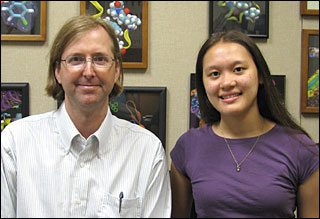New York Blue Supercomputer Serves Intel Science Talent Search Finalist
January 29, 2009
The following news release is being issued today by the U.S. Department of Energy's Brookhaven National Laboratory. NYSTAR has issued a similar news release, which included this quote: "Christine Shrock is a perfect example of when a researcher is given the proper tool, there is no limit to their innovative potential," said New York State Foundation for Science, Technology and Innovation (NYSTAR) Executive Director Edward Reinfurt.
UPTON, NY - One of the world's fastest supercomputers, New York Blue, located at the Department of Energy's Brookhaven National Laboratory, has crunched the data for 2009 Intel Science Talent Search Finalist Christine Lee Shrock of Ward Melville High School in Setauket. Selected from 1,600 applicants, she is one of the 40 national finalists competing for the $100,000 scholarship to be awarded in March.
Shrock, 18, built computer models for her research project in bioinformatics and genomics under the guidance of Stony Brook University chemist Carlos Simmerling. Shrock developed a three-dimensional simulation of a certain protein - a very data-intensive process that requires an enormous amount of computer resources.
That is where New York Blue comes in: about 10,000 times faster than a personal computer, it uses more than 36,000 processors to handle over 100 trillion calculations per second. This capacity allows it to efficiently handle a large and complex 3D model such as Shrock's.
Using her computer simulations, Shrock demonstrated the dynamics of the protein MDM2, research that may lead to a new class of cancer drugs. She focused on MDM2's effects on an important tumor-suppressing protein, p53.
When it is bound to MDM2, p53 is inactivated. During the binding process, a segment of amino acid residue on MDM2 forms a "lid." Shrock showed, through her computer simulation, that when the lid stays open, p53 is bound and inactivated; but when the lid is closed, p53 is free to perform its tumor-suppressing function.
The finding of this lid identification offers a target for cancer therapeutics. Shrock is first author of a manuscript submitted for publication in Protein Science.
Support from the New York State Foundation for Science, Technology, and Innovation (NYSTAR) has helped allow for research using New York Blue in fields from genomics to climate science.
New York Blue is used cooperatively by the Laboratory and Stony Brook University as part of the New York Center for Computation Sciences. Ranked as the 28th fastest supercomputer by Top 500, this supercomputer has had about 200 users since its installment in 2007.
2009-10906 | INT/EXT | Newsroom










